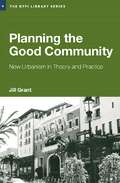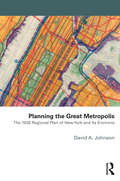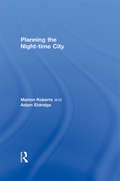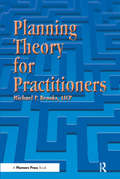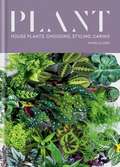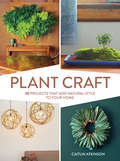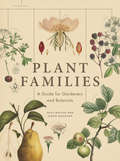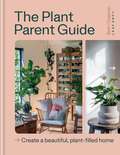- Table View
- List View
Planning the Good Community: New Urbanism in Theory and Practice (RTPI Library Series)
by Jill GrantAn examination of new urban approaches both in theory and in practice. Taking a critical look at how new urbanism has lived up to its ideals, the author asks whether new urban approaches offer a viable path to creating good communities. With examples drawn principally from North America, Europe and Japan, Planning the Good Community explores new urban approaches in a wide range of settings. It compares the movement for urban renaissance in Europe with the New Urbanism of the United States and Canada, and asks whether the concerns that drive today’s planning theory – issues like power, democracy, spatial patterns and globalisation- receive adequate attention in new urban approaches. The issue of aesthetics is also raised, as the author questions whether communities must be more than just attractive in order to be good. With the benefit of twenty years’ hindsight and a world-wide perspective, this book offers the reader unparalleled insight as well as a rigorous and considered critical analysis.
Planning the Great Metropolis: The 1929 regional plan of New York and its environs (Planning, History and Environment Series)
by David A. JohnsonAs the Regional Plan Association embarks on a Fourth Regional Plan, there can be no better time for a paperback edition of David Johnson’s critically acclaimed assessment of the 1929 Regional Plan of New York and Its Environs. As he says in his preface to this edition, the questions faced by the regional planners of today are little changed from those their predecessors faced in the 1920s. Derided by some, accused by others of being the root cause of New York City’s relative economic and physical decline, the 1929 Plan was in reality an important source of ideas for many projects built during the New Deal era of the 1930s. In his detailed examination of the Plan, Johnson traces its origins to Progressive era and Daniel Burnham’s 1909 Plan of Chicago. He describes the making of the Plan under the direction of Scotsman Thomas Adams, its reception in the New York Region, and its partial realization. The story he tells has important lessons for planners, decision-makers and citizens facing an increasingly urban future where the physical plan approach may again have a critical role to play.
Planning the Great Metropolis: The 1929 regional plan of New York and its environs (Planning, History and Environment Series)
by David A. JohnsonAs the Regional Plan Association embarks on a Fourth Regional Plan, there can be no better time for a paperback edition of David Johnson’s critically acclaimed assessment of the 1929 Regional Plan of New York and Its Environs. As he says in his preface to this edition, the questions faced by the regional planners of today are little changed from those their predecessors faced in the 1920s. Derided by some, accused by others of being the root cause of New York City’s relative economic and physical decline, the 1929 Plan was in reality an important source of ideas for many projects built during the New Deal era of the 1930s. In his detailed examination of the Plan, Johnson traces its origins to Progressive era and Daniel Burnham’s 1909 Plan of Chicago. He describes the making of the Plan under the direction of Scotsman Thomas Adams, its reception in the New York Region, and its partial realization. The story he tells has important lessons for planners, decision-makers and citizens facing an increasingly urban future where the physical plan approach may again have a critical role to play.
Planning the Night-time City
by Marion Roberts Adam EldridgeThe night-time economy represents a particular challenge for planners and town centre managers. In the context of liberalised licensing and a growing culture around the '24-hour city', the desire to foster economic growth and to achieve urban regeneration has been set on a collision course with the need to maintain social order. Roberts and Eldridge draw on extensive case study research, undertaken in the UK and internationally, to explain how changing approaches to evening and night-time activities have been conceptualised in planning practice. The first to synthesise recent debates on law, health, planning and policy, this research considers how these dialogues impact upon the design, management, development and the experience of the night-time city. This is incisive and highly topical reading for postgraduates, academics and reflective practitioners in Planning, Urban Design and Urban Regeneration.
Planning the Night-time City
by Marion Roberts Adam EldridgeThe night-time economy represents a particular challenge for planners and town centre managers. In the context of liberalised licensing and a growing culture around the '24-hour city', the desire to foster economic growth and to achieve urban regeneration has been set on a collision course with the need to maintain social order. Roberts and Eldridge draw on extensive case study research, undertaken in the UK and internationally, to explain how changing approaches to evening and night-time activities have been conceptualised in planning practice. The first to synthesise recent debates on law, health, planning and policy, this research considers how these dialogues impact upon the design, management, development and the experience of the night-time city. This is incisive and highly topical reading for postgraduates, academics and reflective practitioners in Planning, Urban Design and Urban Regeneration.
Planning Theory for Practitioners
by Michael BrooksThis book is recommended reading for planners preparing to take the AICP exam. In this new book, the author bridges the gap between theory and practice. The author describes an original approach-Feedback Strategy-that builds on the strengths of previous planning theories with one big difference: it not only acknowledges but welcomes politics-the bogeyman of real-world planning. Don't hold your nose or look the other way, the author advises planners, but use politics to your own advantage. The author admits that most of the time planning theory doesn't have much to do with planning practice. These ideas rooted in the planner's real world are different. This strategy employs everyday poltiical processes to advance planning, trusts planners' personal values and professional ethics, and depends on their ability to help clients articulate a vision. This volume will encourage not only veteran planners searching for a fresh approach, but also students and recent graduates dismayed by the gap between academic theory and actual practice.
Planning Theory for Practitioners
by Michael BrooksThis book is recommended reading for planners preparing to take the AICP exam. In this new book, the author bridges the gap between theory and practice. The author describes an original approach-Feedback Strategy-that builds on the strengths of previous planning theories with one big difference: it not only acknowledges but welcomes politics-the bogeyman of real-world planning. Don't hold your nose or look the other way, the author advises planners, but use politics to your own advantage. The author admits that most of the time planning theory doesn't have much to do with planning practice. These ideas rooted in the planner's real world are different. This strategy employs everyday poltiical processes to advance planning, trusts planners' personal values and professional ethics, and depends on their ability to help clients articulate a vision. This volume will encourage not only veteran planners searching for a fresh approach, but also students and recent graduates dismayed by the gap between academic theory and actual practice.
Plans for Small Gardens: Design, Build, Maintain, Enjoy
by Ann Powell-MarieYou see a wonderful garden on TV, at the Chelsea flower show, or at your neighbours' house, but how do you go about recreating it in your own back yard? In Ann-Marie Powell's Plans for Small Gardens, the Chelsea gold medal winner lists out all the gardening ingredients, as well explaining how to actually create and maintain your garden. This is a book that starts from scratch to allow even gardening novices to build their perfect patch. Choose your recipe – shady, courtyard, family, or edible; collect your ingredients – turf, slabs, containers and plants; and follow the simple method to put the garden together. Detailed planting and construction plans, colour photographs and a handy practical section at the back of the book ensure you have all the resources you need, while year-by-year maintenance guides guarantee that your garden will continue to flourish for years to come.
Plant: House plants: choosing, styling, caring
by Gynelle LeonPlant is a stylish, practical, modern guide to the world of house plants.House plants can change a home in an instant. A flash of colour, a calming influence, they are adaptable, affordable and - if you know how - easy to care for.In Plant, horticultural expert and author of Prick, Gynelle Leon, gives you all the knowledge you need to help your plants thrive. Featuring:- A plant gallery showcasing some of the very best house plants- A chapter of styling ideas to inspire you to show your plants and their best- A care guide with all you need to know to help your plants thrive
Plant Craft: 30 Projects that Add Natural Style to Your Home
by Caitlin AtkinsonPlant Craft features 30 step-by-step projects inspired by the natural world and made out of live plants, cut flowers, foraged branches, and more.
Plant Families: A Guide for Gardeners and Botanists
by Ross Bayton Simon MaughanMost of us lump plants together in one big family, and when pressed can only explain their grouping by what they’re not—not an animal, not a mineral, and so just a plant. In reality, there are hundreds of different plant families, each grouped logically by a unique family history and genealogy. This brings sense and order to the more than a quarter of a million different plant species covering a diverse spectrum that includes soaring sequoias (Cupressaceae), squat prickly pear (Cactaceae), and luxuriant roses (Rosaceae). Plant Families is an easy-to-use, beautifully illustrated guide to the more than one hundred core plant families every horticulturist, gardener, or budding botanist needs to know. It introduces the basics of plant genealogy and teaches readers how to identify and understand the different structures of flowers, trees, herbs, shrubs, and bulbs. It then walks through each family, explaining its origins and range, and describing characteristics such as size, flowers, and seeds. Each family is accompanied by full-color botanical illustrations and diagrams. “Uses For” boxes planted throughout the book provide practical gardening tips related to each family. We have much to gain by learning about the relationships between plant families. By understanding how botanists create these groupings, we can become more apt at spotting the unique characteristics of a plant and identify them faster and more accurately. Understanding plant families also helps us to make sense of—and better appreciate—the enormous biological diversity of the plant kingdom.
Plant Families: A Guide for Gardeners and Botanists
by Ross Bayton Simon MaughanMost of us lump plants together in one big family, and when pressed can only explain their grouping by what they’re not—not an animal, not a mineral, and so just a plant. In reality, there are hundreds of different plant families, each grouped logically by a unique family history and genealogy. This brings sense and order to the more than a quarter of a million different plant species covering a diverse spectrum that includes soaring sequoias (Cupressaceae), squat prickly pear (Cactaceae), and luxuriant roses (Rosaceae). Plant Families is an easy-to-use, beautifully illustrated guide to the more than one hundred core plant families every horticulturist, gardener, or budding botanist needs to know. It introduces the basics of plant genealogy and teaches readers how to identify and understand the different structures of flowers, trees, herbs, shrubs, and bulbs. It then walks through each family, explaining its origins and range, and describing characteristics such as size, flowers, and seeds. Each family is accompanied by full-color botanical illustrations and diagrams. “Uses For” boxes planted throughout the book provide practical gardening tips related to each family. We have much to gain by learning about the relationships between plant families. By understanding how botanists create these groupings, we can become more apt at spotting the unique characteristics of a plant and identify them faster and more accurately. Understanding plant families also helps us to make sense of—and better appreciate—the enormous biological diversity of the plant kingdom.
Plant Grow Harvest Repeat: Grow a Bounty of Vegetables, Fruits, and Flowers by Mastering the Art of Succession Planting
by Meg McAndrews Cowden&“Wonderfully written, beautifully illustrated, and everything you need to know to get more productivity out of your food garden.&” —Joe Lamp&’l, creator and executive producer, Growing a Greener World Discover how to get more out of your growing space with succession planting—carefully planned, continuous seed sowing—and provide a steady stream of fresh food from early spring through late fall. Drawing inspiration from succession in natural landscapes, Meg McAndrews Cowden teaches you how to implement lessons from these dynamic systems in your home garden. You&’ll learn how to layer succession across your perennial and annual crops; maximize the early growing season; determine the sequence to plant and replant in summer; and incorporate annual and perennial flowers to benefit wildlife and ensure efficient pollination. You&’ll also find detailed, seasonal sowing charts to inform your garden planning, so you can grow more anywhere, regardless of your climate. Plant Grow Harvest Repeat will inspire you to create an even more productive, beautiful, and enjoyable garden across the seasons—every vegetable gardener&’s dream.
Plant Love
by Alys FowlerHouseplants are more than just decorations. They turn a room into a living space and breathe life into our interiors. Not all of us can have a garden or even a window box, but everyone can own a houseplant - and everyone should. Not only are they an affordable and attractive way to add a decorative and personal touch to a space, indoor plants also have unique air purifying properties and their presence is good for our health and wellbeing. In this practical yet inspiring guide, gardening expert Alys Fowler explores all the possible indoor plant options available, helping you to find the perfect plant for any location, from cool, shady bedrooms to warm, sunny kitchen windowsills. As well as more traditional indoor plants, Alys looks at specialist plant groups such as indoor tropical edibles, orchids, cacti, succulents and climbers. With her encyclopedic knowledge and trademark inspirational style, this definitive guide will give you all the knowledge you need to care for your plants.
The Plant Lover's Guide to Sedums (The Plant Lover’s Guides)
by Brent HorvathSedums are most popular flowering succulent. They range from groundcovers to large border perennials and are often included in green roof and vertical garden design because of their visual interest and drought tolerance. Sedums changes dramatically with the seasons—in fall, they are rich and earthy while in summer their flowers come in vibrant shades of pink and yellow. The Plant Lover&’s Guide to Sedums includes everything you need to know about these beautiful gems. Plant profiles highlight 150 of the best varieties to grow, with information on zones, plant size, soil and light needs, origin, and how they are used in the landscape. Additional information includes designing with sedums, understanding sedums, growing and propagating, where to buy them, and where to see them in public gardens.
The Plant Lover's Guide to Snowdrops (The Plant Lover’s Guides)
by Naomi SladeSnowdrops have a delicate, quiet beauty. Their white bell-shaped petals are striking alone and in a swath, and they are a harbinger of spring. The Plant Lover&’s Guide to Snowdrops is the first book to make this group of bulbs accessible to the home gardener. It features profiles of 60 hybrids, species, and cultivars, with information on flowering time, distinguishing features, and ease of cultivation. It addition, it shows how to design with snowdrops, and how to grow and propagate them, also offering tips on where to see snowdrops in public gardens and where to buy them. Each Plant Lover&’s Guide in the series is supported by lush, photo-driven design, featuring the most beloved plants and valued expertise of the gardening world in a visual, comprehensive resource.
The Plant Lover's Guide to Tulips (The Plant Lover’s Guides)
by Richard WilfordIn the tradition of creating a valuable library of beautiful, plant-driven books, Timber Press&’s series of Plant Lover&’s Guides are packed with trusted information alongside lush, full-color photography. This guide is perfect for beginning and expert home gardeners who want to celebrate the beauty of tulips.
Plant Names Explained: Botanical Terms and Their Meaning
by Editors of Editors of David & CharlesIf you, like many gardeners, have a fascination for plant names and their derivations, but stop short of wanting to study botanical nomenclature in great depth, this book is for you!Precise naming is essential to be able to identify plants accurately and most gardeners have at least some knowledge of ‘botanical Latin’. But a plant’s full botanical name does much more than give it a unique label. The name can often tell you where the plant originated, who discovered it, what shape it is, and much else besides. What’s more, the name can be used and understood anywhere in the world.This is a book to have with you at the garden centre, and one to keep beside your bed for an entertaining read. Plant Names Explained is an indispensable guide and makes the subject accessible, enjoyable and fun. It shows not only how plant names work, but also how you can make use of them in entertaining as well as practical ways.A selective alphabetical listing of botanical names and their explanations is accompanied by features exploring cultivar names, with translations of foreign terms and lists of plants you can link with special occasions and celebrations, or with personal names. Other features highlight the places, people and plant characteristics that lie behind the names: gardens and nurseries, countries and cities, plant hunters and gardeners, colours, characteristics and habitats.Plant Names Explained is an essential and fascinating guide to the subject. What may at first seem a dry but necessary convention is revealed to be a way of opening up the intriguing world of plants.
Plant Organs (large print)
by RnibThis page shows an image of a small plant growing in the ground. There is a locator dot shown, which will be at the top left, when the image is the correct way up. The image is surrounded by a dashed line image border. The green leafy part of the plant is in the top half of the page and the root is in the bottom half of the page. The plans stem goes vertically up the middle of the page. It has three oval leaves on the left, one at the top forming the shoot, and four leaves on the right. Curved arrows indicate water loss as vapour from the leaves. A line going horizontally across the middle of the page represents the soil surface. Down from this the soil is shown in cross section so the roots can be found. As the root goes down the page it divides into smaller multiples of roots. Arrows show the root absorbing water from the soil.
Plant Organs (UEB contracted)
by RnibThis page shows an image of a small plant growing in the ground. There is a locator dot shown, which will be at the top left, when the image is the correct way up. The image is surrounded by a dashed line image border. The green leafy part of the plant is in the top half of the page and the root is in the bottom half of the page. The plans stem goes vertically up the middle of the page. It has three oval leaves on the left, one at the top forming the shoot, and four leaves on the right. Curved arrows indicate water loss as vapour from the leaves. A line going horizontally across the middle of the page represents the soil surface. Down from this the soil is shown in cross section so the roots can be found. As the root goes down the page it divides into smaller multiples of roots. Arrows show the root absorbing water from the soil.
Plant Organs (UEB uncontracted)
by RnibThis page shows an image of a small plant growing in the ground. There is a locator dot shown, which will be at the top left, when the image is the correct way up. The image is surrounded by a dashed line image border. The green leafy part of the plant is in the top half of the page and the root is in the bottom half of the page. The plans stem goes vertically up the middle of the page. It has three oval leaves on the left, one at the top forming the shoot, and four leaves on the right. Curved arrows indicate water loss as vapour from the leaves. A line going horizontally across the middle of the page represents the soil surface. Down from this the soil is shown in cross section so the roots can be found. As the root goes down the page it divides into smaller multiples of roots. Arrows show the root absorbing water from the soil.
The Plant Parent Guide: Create a beautiful, plant-filled home
by Beth ChapmanDid you know we spend an average of 90% of our time indoors? With the air-purifying, mind-calming, stress-relieving and productivity-boosting power of houseplants well established, it is time to transform your home with plants.Created by leading houseplant brand Leaf Envy, The Plant Parent Guide is here to reveal the incredible world of houseplants, but also teach you to select, style and care for them in the best way to suit your space.Upgrade your home with perfectly placed greenery by following the bespoke styling guides for every room, from shaded bedrooms to steamy bathrooms. Whether you're looking for the perfect Zoom backdrop or an oasis of calm in a busy kitchen, there are plenty of tips and tricks for choosing the best plants to suit your light, upkeep and styling requirements.Easy-to-follow care guides make becoming a plant parent pro simple, with advice for every season to ensure your plants flourish year-round. For houseplant newbies there are recommendations for the species hardest to kill, while for the already green-fingered there are ideas for more unusual plants to introduce, and instructions for mastering the art of propagation. With The Plant Parent Guide, any home can become a beautiful and thriving plant-filled space.Photography by Taran Wilkhu.
Plant Parenting: Easy Ways to Make More Houseplants, Vegetables, and Flowers
by Leslie F. HalleckA hardworking, step-by-step guide to the easiest, most affordable techniques for making more plants—houseplants, vegetables, flowers, and more.
Plant Partners: Science-Based Companion Planting Strategies for the Vegetable Garden
by Jessica WalliserCompanion planting has a long history of use by gardeners, but the explanation of why it works has been filled with folklore and conjecture. Plant Partners delivers a research-based rationale for this ever-popular growing technique, offering dozens of ways you can use scientifically tested plant partnerships to benefit your whole garden. Through an enhanced understanding of how plants interact with and influence each other, this guide suggests specific plant combinations that improve soil health and weed control, decrease pest damage, and increase biodiversity, resulting in real and measurable impacts in the garden. This publication conforms to the EPUB Accessibility specification at WCAG 2.0 Level AA.
